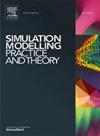GrC-VMM: An intelligent framework for virtual machine migration optimization using granular computing
IF 3.5
2区 计算机科学
Q2 COMPUTER SCIENCE, INTERDISCIPLINARY APPLICATIONS
引用次数: 0
Abstract
Virtual Machine Migration (VMM) is a critical component in cloud computing environments, enabling dynamic resource management and system optimization. However, existing approaches often face challenges such as increased downtime, excessive resource consumption, and complex decision-making processes in heterogeneous environments. This paper presents a novel framework based on Granular Computing (GrC) principles to address these challenges through systematic VM categorization and prioritization. The proposed framework employs a three-stage approach: (1) feature extraction and granule formation, converting VM attributes such as workload, downtime sensitivity, and resource utilization into meaningful information granules; (2) granule-based decision rule generation using formal GrC methodologies; and (3) priority-based classification using weighted membership functions. Experimental evaluations conducted using CloudSim 5.0 demonstrate the framework’s effectiveness across multiple performance dimensions. The results show 92. 1% classification accuracy, 83. 7% resource utilization and reduced migration downtime of 1.9 s. The framework exhibits linear computational complexity O(N), confirming its scalability for large-scale deployments. Additionally, performance analysis under various workload patterns (resource-intensive, service-oriented, and mixed) validates the framework’s robustness and adaptability. These results suggest that the proposed GrC-based approach offers a promising solution to optimize VM migration in cloud environments while maintaining operational efficiency and service quality.
GrC-VMM:一个使用颗粒计算优化虚拟机迁移的智能框架
虚拟机迁移(VMM)是云计算环境中的一个关键组件,可以实现动态资源管理和系统优化。然而,现有的方法经常面临挑战,例如在异构环境中增加停机时间、过度的资源消耗和复杂的决策过程。本文提出了一个基于颗粒计算(GrC)原则的新框架,通过系统的VM分类和优先级来解决这些挑战。该框架采用三阶段方法:(1)特征提取和颗粒形成,将虚拟机属性(如工作负载、停机灵敏度和资源利用率)转换为有意义的信息颗粒;(2)采用形式化GrC方法生成基于颗粒的决策规则;(3)基于优先级的加权隶属函数分类。使用CloudSim 5.0进行的实验评估证明了该框架在多个性能维度上的有效性。结果显示为92。1%的分类准确率,83。7%的资源利用率和减少1.9秒的迁移停机时间。该框架显示出线性计算复杂度O(N),证实了其大规模部署的可伸缩性。此外,各种工作负载模式(资源密集型、面向服务的和混合的)下的性能分析验证了框架的健壮性和适应性。这些结果表明,提出的基于grc的方法提供了一个有前途的解决方案,可以在保持运营效率和服务质量的同时优化云环境中的VM迁移。
本文章由计算机程序翻译,如有差异,请以英文原文为准。
求助全文
约1分钟内获得全文
求助全文
来源期刊

Simulation Modelling Practice and Theory
工程技术-计算机:跨学科应用
CiteScore
9.80
自引率
4.80%
发文量
142
审稿时长
21 days
期刊介绍:
The journal Simulation Modelling Practice and Theory provides a forum for original, high-quality papers dealing with any aspect of systems simulation and modelling.
The journal aims at being a reference and a powerful tool to all those professionally active and/or interested in the methods and applications of simulation. Submitted papers will be peer reviewed and must significantly contribute to modelling and simulation in general or use modelling and simulation in application areas.
Paper submission is solicited on:
• theoretical aspects of modelling and simulation including formal modelling, model-checking, random number generators, sensitivity analysis, variance reduction techniques, experimental design, meta-modelling, methods and algorithms for validation and verification, selection and comparison procedures etc.;
• methodology and application of modelling and simulation in any area, including computer systems, networks, real-time and embedded systems, mobile and intelligent agents, manufacturing and transportation systems, management, engineering, biomedical engineering, economics, ecology and environment, education, transaction handling, etc.;
• simulation languages and environments including those, specific to distributed computing, grid computing, high performance computers or computer networks, etc.;
• distributed and real-time simulation, simulation interoperability;
• tools for high performance computing simulation, including dedicated architectures and parallel computing.
 求助内容:
求助内容: 应助结果提醒方式:
应助结果提醒方式:


